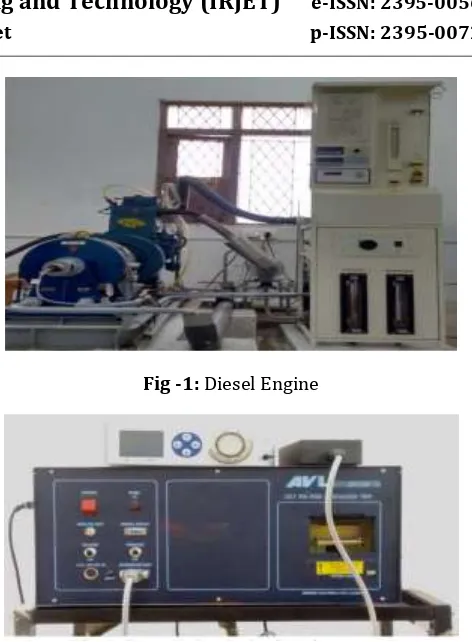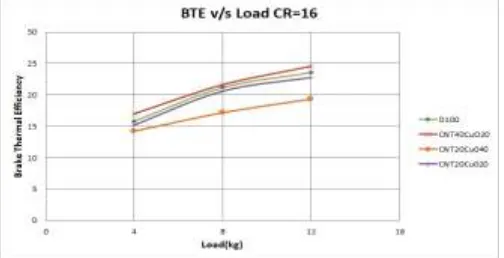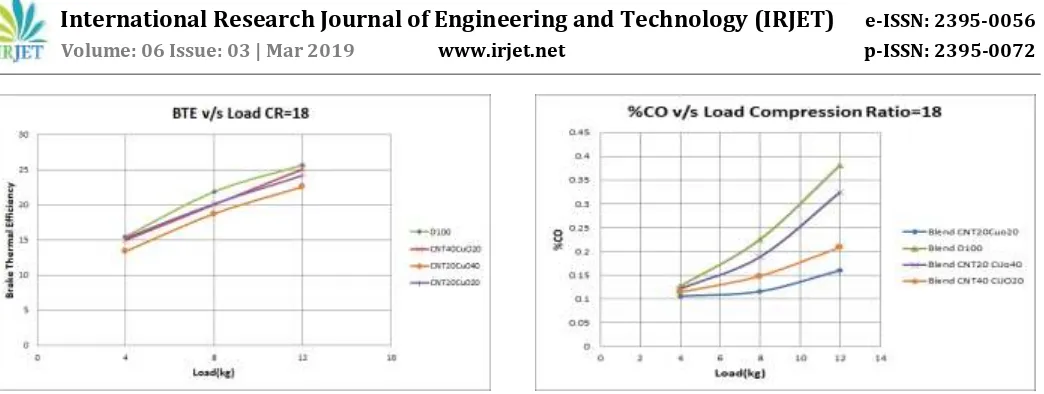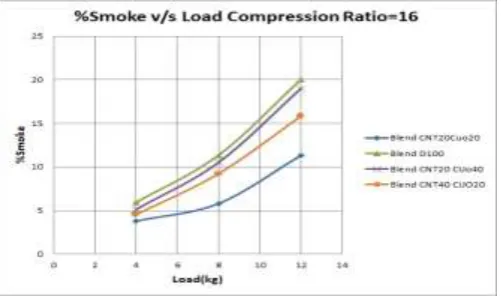© 2019, IRJET | Impact Factor value: 7.211 | ISO 9001:2008 Certified Journal
| Page 5143
Effect of Copper Oxide and Carbon Nanotubes as Additives in Diesel
Blend on the Performance and Emission Characteristics of a Variable
Compression Ratio Engine
Dr. Atul G. Londhekar
1, Aashutosh Amberkar
2, Danish Anas
3, Karan Arora
4, Arafat Ansari
51
Assistant Professor, Department of Mechanical Engineering, Rajiv Gandhi Institute of Technology, Mumbai,
Maharashtra, India.
2,3,4,5
Student, Department of Mechanical Engineering, Rajiv Gandhi Institute of Technology, Mumbai,
Maharashtra, India.
---***---Abstract -In this study, a blend of bio-diesel and pure diesel in the ratio of 20:80 was used with Nano additives. The additives that were used were multi walled carbon Nano-tubes (MWCNT) and copper oxide particles (CuO). The bio-diesel used was Karanja oil (Pongamia oil) after transesterification. The tests were carried out on 20ppm and 40ppm blends in various proportions of both the additives. The blends were prepared using an ultrasonicator of 40-60 Hz frequency. The experimental set-up consisted of single cylinder 4-stroke, constant speed DE coupled with eddy current dynamo meter loading device. For exhaust gas analyzing a 4- gas analyzer (model HG-540) was used with a Hartridge smoke meter for checking smoke emissions. The results were generated using a data acquisition system comprising of high-pressure piezoelectric pressure sensor & a crank angle encoder. The experiments were carried out on engine speed of 1500rpm. Results obtained were compared with pure diesel and only diesel-bio diesel blend as base lines. The results showed promising improvement in break power output at high loads with slight changes in emission gases when MWCNT and CuO were present in the blends.
Key Words: Carbon Nanotubes, Copper Oxide, Pongamia,
Additives, Brake Power, Emissions, Bio-diesel, DE.
1. INTRODUCTION
Energy plays vital role in the developmental activities of a country. Nature has gifted earth with various energy sources Among the various energy sources, fossil fuel has been preferred by all due its high calorific value, safety for usage, easy to transport, safety to storage and easy adaptability with technological changes [1]. The DEs are considered to be stronger and economic than gasoline engines. However, they produce hazardous exhausts such as oxides of nitrogen (NOx), particulates of matter, smoke, and obnoxious odour in high magnitudes. Various methods such as design modification of engine, fuel modification, exhaust gas treatment, etc. have been tried for improvement of output characteristics and reduce harmful exhaust from the DEs,. Previously it has been researched by incorporation of some chemical reagents in diesel and modifying the fuel by several of researchers as well [2]. A lot of research is being conducted on Nano particles for application in DE. These
Nano fuels are being considered as secondary energy carrier. The Nano particles blended fuels exhibit significantly different thermal and physical characteristics than the base fuels from which they were derived [3].
Other than that, Biodiesel can be used as an alternative fuel in DEs. Bio-diesel can be obtained from both animal as well as plant origins. It is synthesized from various plants like soybean, pongamia, mustard, jojoba, etc. and in regards of animal origin yellow oil, chicken oil, whale oil, shark oil, etc. serve as the sources [4]. Biodiesel can be obtained continuously by organic means, it is no hazardous, does not catch fire quickly making its storage easier, it is non explosive and also biodegradable thus making it eco-friendlier. It is cleaner than the pure diesel. But its energy content is lower and it produces NOx while burning, also it has higher density and viscosity which is a setback for the biodiesel applications [5,6]. This can be overcome by incorporating the Nano additives concept with Biodiesel as well.
Now in regards of Nano additives blends, Cerium Oxide (CeO2), Aluminium oxide (Al2O3) has been tested upon quite
© 2019, IRJET | Impact Factor value: 7.211 | ISO 9001:2008 Certified Journal
| Page 5144
2. LITERATURE REVIEW
Marquis and Chibante’s [8] work on carbon Nano-tubes (CNT) indicated that the suspended CNT in a base fluid will enhance the surface-area-to-volume ratio and settling time. Sadhik Basha and Anand [9] experimented for CNT blended diesel and found out great enhancement in brake thermal efficiency as well as reduction in harmful exhaust compared to neat diesel. This is assumed to be due to better firing. The same team have critically reviewed the applications of Nano-particle/Nano-fluid in DEs and concluded that adding suitable proportion of nanoparticles/CNT to the conventional fuels such as diesel will reduce the evaporation time, which in turn favors shorter ignition delay.
3. EXPERIMENTAL SETUP & PROCEDURE
[image:2.595.318.554.55.376.2]Engine Test: The testing was done on a standard single cylinder four stroke compression ignition engine with direct injection. Table 1 lists the engine specifications and operating conditions used in this experiment. Fig. 1 illustrates the engine, eddy current dynamometer. Fig. 2 shows the exhaust gas analyzer and smoke meter. The data acquisition system comprising piezoelectric pressure sensor and a crank angle decoder has been used to measure performance parameters like BP and fuel consumption. Thermocouples has been used to measure the exhaust gas temperature. Exhaust gas emissions were measured by AVL DiGAS 444 analyzer, smoke opacity is measured by AVL smoke opacity meter. Engine was loaded using the dynamometer run with eddy currents. Flow rate for fuel was measure with help of a burette timed with a stopwatch. For emission characteristics HARTRIDGE smoke meter and 4-gas analyzer (HG-540) make equipment were used during the steady state operation. The test was carried out for compression ratios of 16 and 18 for the constant engine speed of 1500 rpm.
Table -1: Diesel Engine specifications
Fig -1: Diesel Engine
Fig -2: Gas Analyzer & Smoke meter
3.1 BLEND PREPARATION
[image:2.595.36.284.543.671.2]The Nano particles of MWCNT and CuO were measured to pre-calculated mass fractions for 20 and 40 ppm. The diesel and bio-diesel mixture were prepared in ratios 80:20. According to blend required then the measured particles were added to the mixture in various ratios to prepare blends with CNT20CuO20, CNT20CuO40, CNT40CuO20 ppm. Then the complete mixtures to be made homogeneous and to disperse nano particles completely, subjected to vibrations using an ultrasonicator for set time. This stage was actual testing for extensive performance and exhaust emissions of the engine using the prepared blends.
[image:2.595.318.552.571.741.2]© 2019, IRJET | Impact Factor value: 7.211 | ISO 9001:2008 Certified Journal
| Page 5145
4. ENGINE PERFORMANCE
This section reports the result of additives used in DE and its effect on performance characteristics specifically BSFC, BP and BTE at different loads for CR of 16 and 18.
4.1EFFECT ON BRAKE SPECIFIC FUEL CONSUMPTION
[image:3.595.305.563.53.220.2] [image:3.595.36.288.255.397.2] [image:3.595.305.560.256.404.2]BSFC is a measure of utilization of fuel supplied to the engine for developing BP. BSFC is defined as the mass flow rate of fuel per unit BP developed. The changes of BSFC with load of 4,8,12 kg for CR of 16 and 18 is shown in figure 4.1.
[image:3.595.36.290.431.580.2]Fig -4.1: Changes of BSFC with different loads at CR=16
Fig -4.2: Changes of BSFC with different loads at CR=18
4.2 EFFECT ON BRAKE POWER
The changes of BP with load of 4,8,12 kg for compression ratio 16 and 18 is shown in figure 4.1 and 4.2 respectively.
[image:3.595.309.561.616.745.2]The changes of BP versus load of 4,8,12 kg RPM is shown in figure 4.1 it is observed that at 12 kg load for compression ratio 18, the CNT40 CuO20 has the highest magnitude of 3.42 kW as compared to pure diesel. It may be due to the fact that at higher compression ratios, the mixture gets compressed in a very small space thus causing better mixing of fuel.
Fig -4.1: Changes of BP with different loads at CR=16
Fig -4.2: Changes of BP with different loads at CR=18
4.3 EFFECT ON BRAKE THERMAL EFFICIENCY
4.3.1 Compression Ratio = 16
The changes of BTE against load of 4,8,12 kg RPM is shown in figure 4.2. It is observed that, for 12 kg load, CNT40CuO20 blend has the maximum value of BTE equal to 24.53% as compared to pure diesel, whereas CNT20Cu040 being the lowest which makes it undesirable to use at high loads.
The changes of BTE with load of 4,8,12 kg RPM is shown in figure 4.2. It is observed that, for 12 kg load, D100has slight increment in BTE as compared to CNT20Cu020, CNT40CuO20 blend.
© 2019, IRJET | Impact Factor value: 7.211 | ISO 9001:2008 Certified Journal
| Page 5146
Fig -4.2: Changes of BTE with different loads at CR=18
5. EMISSION CHARACTERISTICS
[image:4.595.297.561.477.623.2]5.1 VARIATION OF CARBON MONOXIDE EMISSIONS
Figure shows the changes of CO for different blends and neat diesel fuel with CR of 16 & 18. It is observed that the CO gradually decreases with the increase in CR. At 12 kg load with the CR of 18, the CO for CNT20 CuO20 is 0.16% and 58% reduction of CO is achieved when compared with the neat diesel fuel. This is due to complete burning; less dilution of charge by residual gases which accelerates the oxidation of carbon to form carbon dioxide. Further, it is also due to increment in CR which actually increases the air temperature inside the cylinder and consequently reduction in delay period causes better and complete burning of the fuel and lowers the CO emissions.
Fig -5.2: Changes of %CO with different loads at CR=16
Fig -4.2: Changes of %CO with different loads at CR=18
5.2 VARIATION OF HYDRO CARBON EMISSION
It is found that increment in HC emission is observed with decrease in the magnitude of compression ratio, due to slow combustion process. Figure shows the changes of HC for different blends and conventional diesel fuel with CR of 16 & 18. At 12 kg load with the CR of 18. 52% reduction in HC emission is achieved by CNT20 CuO20 when compared with the neat diesel fuel. This is due to increment in the air temperature at the end of compression stroke, enhancement in CT, and reduction in charge dilution which ultimately leads to complete burning of fuel and reduction in HC emissions. This is also because of better kindling of biodiesel inside the combustion chamber due to the availability of oxygen in biodiesel when compared to neat diesel fuel.
[image:4.595.38.302.478.624.2]© 2019, IRJET | Impact Factor value: 7.211 | ISO 9001:2008 Certified Journal
| Page 5147
Fig -4.2: Changes of %HC with different loads at CR=18
5.3 VARIATION OF NOx EMISSIONS
Pressure & Temperature plays an important role in the formation of NOx emissions. High Cylinder temperature and pressure which occurs in the combustion chamber during the combustion process can cause Nitrogen to react with oxygen to form oxides of nitrogen (NOx). It is observed that the NO𝑥 gradually increases with the increase in CR. At 12 kg load with the compression ratio of 18, the NO𝑥 for CNT40 CuO20 is 916 ppm and that of neat diesel fuel 1059 ppm. This is due to increment in compression ratio and increment in the combustion pressure and temperature which accelerates the oxidation of nitrogen to form oxides of nitrogen. Further it is also due to increment in compression ratio and increment in the CT which in turn increases the compression ratio which leads to increment in NO𝑥 emission. At high compression ratio, ignition delay reduces and peak pressure increases resulting in high CT and leads to an increment in NO𝑥 emission. At all loads, CNT40CuO20 blend has the minimum temperature and pressure rise in the combustion chamber as compared to pure diesel which led to significant decrease in NOx emissions.
Fig -4.2: Changes of %NOx with different loads at CR=16
Fig -4.2: Changes of %NOx with different loads at CR=18
5.4 VARIATION OF SMOKE OPACITY
Figure shows the changes of smoke for different blends and conventional diesel fuel with CR of 16 & 18. It is observed that opacity gradually decreases with the increase in CR.
Fig -4.2: Changes of Smoke with different loads at CR=16
© 2019, IRJET | Impact Factor value: 7.211 | ISO 9001:2008 Certified Journal
| Page 5148
6. CONCLUSIONS
The results and outputs of the tests conducted are summarized as follows.
1. BP had small increment for all the blends specifically for CNT40CuO20 blend by approximately 2% compared to pure diesel. 2. Brake thermal efficiency also showed good
increment with maximum increment of 3.9% for the CNT40CuO20 blend than the pure diesel at high load for CR of 16.
3. The CO emissions were reduced by maximum of 20% for the blend of CNT40CuO20. Other blends also showed great reduction regarding CO emissions.
4. HC emissions were reduced by 19% for the CNT20CuO20 blend than pure diesel.
5. NOx emissions were also reduced by 18.8% for the CNT40CuO20 blend compared to pure diesel only. 6. Smoke emissions also showed a great decrease in
CNT20CuO20 blend compared to pure diesel. 7. In overall aspects all of the blends prepared showed
good results in performance as well as emissions aspects.
8. Considering all the blends tested, CNT40CuO20 blend was most efficient with CNT20CuO20 blend as the next most efficient one.
9. The study can be further extended with other proportions of the additives used or with some other combinations of the additives.
7. REFERENCES
[1] Karmee Sanjib Kumar, Chadha Anju. Preparation of biodiesel from crude oil of Pongamia pinnata. Bioresour Technol 2005; 96:1425–9.
[2] Ghojel, J., Honnery, D., and Al-Khaleefi, K. Performance, emissions and heat release characteristics of direct injection diesel engine operating on diesel oil emulsion. Application. Thermal Engineering, 2006, 26, 2132– 2141.
[3] Wen. D, Nano fuel as potential secondary energy carrier, Energy environment Science, 2010, 3: pp 591 – 600.
[4] Agarwal AK, Gupta JG, Dhar A. Potential and challenges for large-scale application of biodiesel in automotive sector. Prog Energy Combust Sci 2017; 61:113–49.
[5] Mofijur M, et al. Effect of biodiesel from various feedstocks on combustion characteristics, engine durability and materials compatibility: a review. Renew Sustain Energy Rev 2013; 28:441–55.
[6] Rahman MM, et al. Performance and emission analysis of Jatropha curcas and Moringa oleifera methyl ester fuel blends in a multi-cylinder diesel engine. J Cleaner Prod 2014; 65:304–10.
[7] M. Annamalai, B. Dhinesh, K. Nanthagopal, P. SivaramaKrishnan, J.I. JoshuaRamesh Lalvani, M. Parthasarathy, K. Annamalai, an assessment on performance, combustion and emission behavior of a diesel engine powered by ceria nanoparticle blended emulsified biofuel, Energy Convers. Manage. 123 (2016) 372–380.
[8] Marquis, E. D. S. and Chibante, L.P.F. Improving the heat transfer of nanafluids and lubricants with carbon nanotubes. J.Miner, Metals Mater, Society, 2005 57, 32, 43



